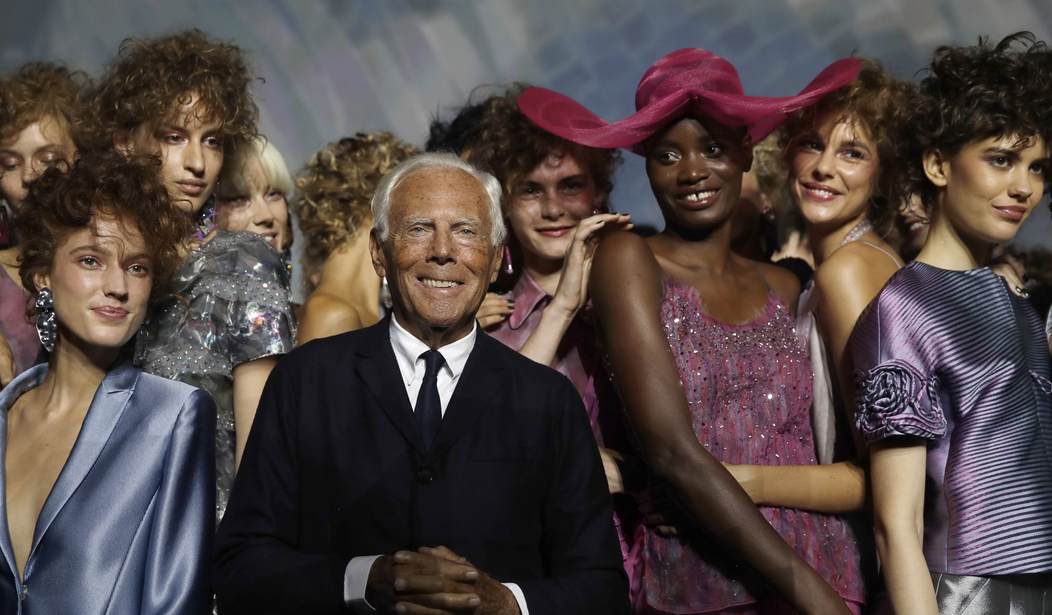So, it was a long and lonely summer. I broke my shoulder in Mexico and had to have a total replacement. I’m sort of bionic now, which is rad because "The Bionic Man" was my favorite as a kid. I’m partially titanium as a result, not just skin and bones. But it was a long process. I spent the entire summer in physical therapy and couldn’t write for a while, couldn’t even pick up a book. So I read less than I normally do. But I healed—still healing—and managed to spend a month starting in late October in Costa Rica and travel to other places and read along the way.
The faves follow:
"Per Amore," Giorgio Armani
Likely due to my mother, who was in the business when I was very small and remained attuned to it throughout her life, I've always had an interest in fashion and the colorful players in and dynamics of the fashion world. I have a particular thing for Giorgio Armani, so when I saw that he had expanded on an illustrated book he did for Rizzoli in 2015 in the form of "Per Amore" ("For Love"), of course I was in a hurry to get my hands on a copy.
The early chapters about his childhood and the start of his career are detailed enough and quite interesting, but then there's a shift about midway through to a hodgepodge of generally 2-3 page chapters focused on Armani's general thoughts on a variety of topics with titles ranging from "Fantasizing" to "Milan" to "Ethics as Aesthetics," "Loving Sports" and so on. It's like a little diary, really--a crack of a window into his world and thinking--which is fine and which is how the book has pretty much been advertised.
It's also been advertised as the closest thing to an autobiography from his own hand we are going to get, and that's a shame, because a full-blown memoir from Giorgio Armani would be an important addition to the annals of fashion history and ingenuity--not to mention something I'd die to read. But we take what we get, I suppose.
It's ultimately a lovely little book (just a few pages over 200, many of which are outstanding photos from throughout his life and career), but I think in order to get much out of it narrative-wise, you really have to be into the man and the House of Armani. I enjoyed it, but even I found it a bit rushed, self-congratulatory, and rather repetitive at times. Also, just a tad puzzling in some areas (for example, he chastises the industry pretty mercilessly for several excesses--such as Cruise Shows, for example--none of which he seems to have stopped engaging in). So again, if you are really into Mr. Armani and his extraordinary empire, this is definitely worth your while and something you'll want in your library. The 4 stars are for you. If you're only mildly interested or altogether ambivalent, "Per Amore" is more like a 3-ish and probably something to skip.
"The Real James Bond: A True Story of Identity Theft, Avian Intrigue, and Ian Fleming," Jim Wright
As an unapologetic James Bond / Ian Fleming fanboy since my teens, I’ve been aware of the simple story of how Ian Fleming’s iconic spy got his name for years. Fleming had just finished his first book, "Casino Royale," and was trying to think of a plain, non-exotic name for his otherwise colorful protagonist. Having a keen interest in bird watching, Fleming turned to a book in his library, the famed "Birds of the West Indies" by one of the leading American ornithologists of the day, James Bond. Staring at the name on the spine, something clicked for Fleming--and voila, he had his name. Interesting little bit of trivia, but that’s about it, right?
So when Jim Wright’s book caught my attention, I was skeptical that the event of that day in 1953 at Goldeneye, Fleming’s Jamaican refuge, could warrant much more than a few paragraphs, much less an entire book.
But wait! Comes Wright decades later to explain that there is in fact a lot more to the story—from how it impacted the lives of ornithologist Bond and his wife Mary (disruptive--but Mary, in particular, milked it pretty hard) to some startling coincidences (“birdwatcher” is an old term for spy; many prominent ornithologists of the day were recruited into the OSS, predecessor of the CIA, as spies in their regions of expertise—and there exists some evidence that leads to the possibility of Bond having actually been among them—to name a few) that make it seem like the random choice was written in the stars.
"The Real James Bond" is an engaging, quick, yet highly insightful read, and not just for Bond geeks like me (and it features some pretty great photos to boot). It's a truly multi-tiered education not just in Bond lore, but ornithology and ornithologists in America during a particularly pioneering era, spycraft, coincidences and a host of almost too-good-to-be-true real-life characters. All in just 144 pages. An entirely unexpected and delightful surprise, this one.
I’m running out of space, but I will direct you to the others that moved me since the summer column: "The Bhagavad Ghita," a 700-verse Hindu script full of life lessons focusing on the immortal soul which all should read; "Up in the Old Hotel," a series of magazine essays by the legendary Joseph Mitchell from back in the day when excellent essay writing was not a lost art; "A Moveable Feast," by Ernest Hemingway, a posthumously published memoir and series of essays from his time in Paris in the 1920s; and finally "How Do We Get Out of Here," a long-awaited rollicking memoir from my good and clever old buddy and founder / editor of The American Spectator, R. Emmett Tyrrell, Jr. I’m going to write a separate column about that one later because I have a lot to say and a lot of history there. Happy reading and here’s to a great 2024!










Join the conversation as a VIP Member